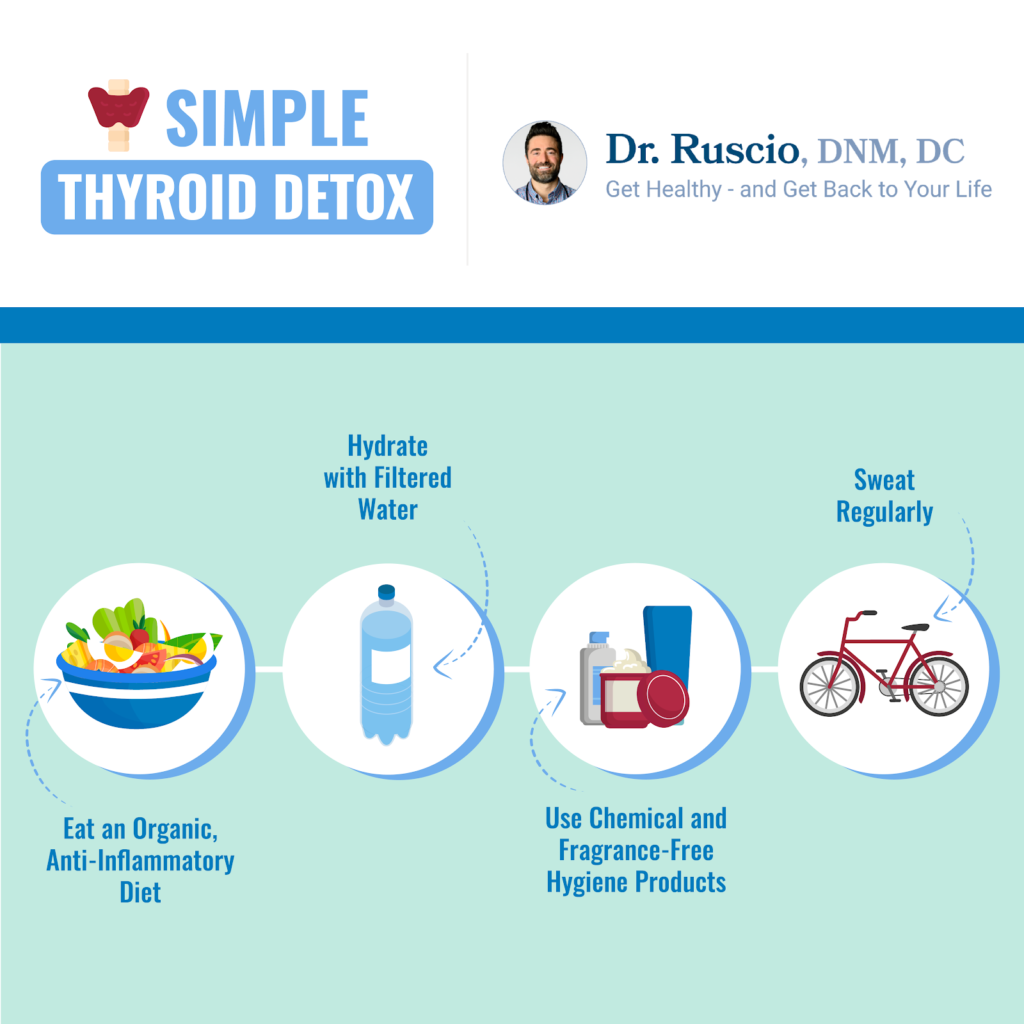Do You Need a Thyroid Detox?
4 Simple Detox Tips for Thyroid Health
- Thyroid and Chemical Pollution|
- Assessing Toxins|
- Simple Thyroid Detox|
- Filtered Water|
- Sweat Regularly|
- Chemical-Free Hygiene Products|
- Supplements for Detox?|
- The Bottom Line|
Endocrine-disrupting chemicals interfere with how the body’s hormone system works, and they’re sadly pervasive in the modern world. This means your thyroid gland is vulnerable to environmental pollutants and chemicals. 1
You may wonder if you can do a thyroid detox from chemicals to improve your thyroid issues. Unfortunately, research doesn’t shed much light on this topic. However, we know two things which we can use to create sensible guidelines for managing thyroid problems:
- We’re all exposed to environmental pollutants.
- The best approach to a thyroid detox is a simple diet and lifestyle clean up.

Thyroid Disease and Chemical Pollution
There’s no doubt that exposure to certain chemical pollutants, in some cases in very small doses, is associated with thyroid disorders. 2 3 4 5 6 Chemicals that have been shown to disrupt thyroid health include: 7
- PCBs 3 4 5 6 7 12 13 14
- BPA 2 6 7
- Perchlorate 6 7 10
- Dioxins 6 7
- Pesticides and herbicides [2 5 6 7
- Flame retardants 7
- Phthalates 2 7
- Heavy metals (mercury, lead, and cadmium) 6 7 8
These chemicals can impair thyroid gland function or disrupt how thyroid hormones work in the body, causing thyroid symptoms such as fatigue, anxiety or depression, weight gain, weight loss, dry skin, or brain fog. 9
For example, perchlorate, a manufactured industrial chemical that also occurs naturally in some soils, is a known thyroid inhibitor. It has been used as a thyroid medication for hyperthyroidism treatment, because it suppresses the T4 and T3 thyroid hormone. 10 Perchlorate contamination has been found in drinking water, breast milk, and soils in the U.S., and exposure to the chemical can lead to hypothyroidism. 11
Exposure to some of these chemicals also appears to be associated with autoimmune thyroid diseases, including Hashimoto’s thyroiditis and Graves’ disease (both are types of autoimmune hyperthyroidism). For example, persistent organic pollutants (PCBs) have been shown to be associated with increased levels of thyroid antibodies. 12 13 14
All of this may sound scary and make you feel like you need to get tested for environmental toxins. However, testing might not be the best use of your healthcare dollars.
Assessing Toxins
We don’t have effective ways to test for low-level exposure to endocrine-disrupting chemicals.
You may have heard about blood tests, urine tests, and hair tests that look for metals or volatile organic compounds in your body. Unfortunately, most of this testing hasn’t been fully validated, 15 16 17 nor has detoxing been shown to provide meaningful clinical results for patients. 18
If you can’t assess whether you have toxin exposure, you may wonder if you should do a thyroid detox.
It’s not necessary to do a detox for specific chemicals for your thyroid health. Instead, we can assume that most people are exposed to pollutants. However, you can lower pollutants’ effects on your body with simple diet and lifestyle changes. These changes will take advantage of your body’s natural detoxification processes.
Simple Detox for Thyroid Health: Eat an Organic, Anti-inflammatory Diet
A low-quality diet is typically the single biggest source of inflammation for your body and can negatively impact your immune system.
Decreasing the burden of inflammation in your body is helpful for managing almost any thyroid condition, as inflammation is associated with thyroid imbalances. 19 20 21 22 23 It can also greatly improve your overall health.
A simple, anti-inflammatory detox diet includes:
- Organic foods, which are free of chemical pesticides and herbicides.
- Real, unprocessed foods, which are free of additives and chemical preservatives. These include:
- Fruits and veggies
- Healthy fats
- Gluten-free whole grains
- Free-range, grass-fed, or wild-caught meat, fish, and poultry
- Nuts and seeds
- Avoid any known food allergies, as these contribute to inflammation.
- There’s no one right thyroid diet, but a low-iodine diet may help thyroid conditions, especially hypothyroid autoimmune disease. 24
Eating a simple, real food diet is the foundation of any detox. Following such a diet will both help reduce inflammation and improve your gut health.
Filter Your Water
There is some evidence that water additives like fluoride can impact thyroid gland function 25 because it can impair its ability to absorb iodine. Drinking water can also be a source for other types of thyroid-toxic chemicals like lead, perchlorates, and pesticides.
To support your body’s natural detox functions, filter your drinking water and stay well hydrated. Choose a water filter that removes heavy metals, pesticides and herbicides, and other chemicals. If your water is treated with fluoride, make sure to choose a filter that removes this as well. This information is usually listed on the filter packaging.
Sweat Regularly
One of the main ways your body detoxes naturally is by sweating. Regular exercise and sauna usage promotes sweating, which naturally helps your body detox. Aim to break a sweat daily to access these important health benefits.
Chemical- and Fragrance-Free Hygiene Products
It’s been shown that chemicals can easily be absorbed through the skin. 26 Many conventional hygiene products contain ingredients and fragrances that may affect your thyroid health. So, do an easy home detox by ensuring your products are natural and fragrance-free. This especially applies to products you put on your skin, like soaps, lotions, shampoos, and deodorants.
Are Supplements Necessary for Thyroid Detox?
Some functional medicine providers sell expensive detox programs that include supplements intended to support the body’s detoxification pathways. However, there is little solid evidence that high doses of detox nutrients actually help or are good medical advice. Additionally, there is no evidence that supplement-based detox programs improve thyroid function.
However, keep in mind your body already has natural detoxification systems that normally work very well. A simple diet and lifestyle detox can reduce the burden of toxins in your body and support your natural detoxification systems.
The Bottom Line
There is little evidence to suggest that attempting to detox specific chemicals will improve your thyroid condition. A better approach is to reduce inflammation with a clean diet and non-toxic hygiene products. You can also support your body’s normal detox function by hydrating with filtered water and engaging in exercise and sauna time to make you sweat.
Dr. Michael Ruscio is a DC, natural health provider, researcher, and clinician. He serves as an Adjunct Professor at the University of Bridgeport and has published numerous papers in scientific journals as well as the book Healthy Gut, Healthy You. He also founded the Ruscio Institute of Functional Health, where he helps patients with a wide range of GI conditions and serves as the Head of Research.
Discussion
I care about answering your questions and sharing my knowledge with you. Leave a comment or connect with me on social media asking any health question you may have and I just might incorporate it into our next listener questions podcast episode just for you!